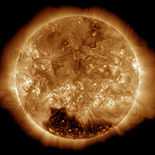Solar mass

The solar mass (M☉) is a standard unit of mass in astronomy that is used to indicate the masses of other stars, as well as clusters, nebulae and galaxies. It is equal to the mass of the Sun, about two nonillion kilograms:
The above mass is about 332,946 times the mass of the Earth (M⊕), or 1,048 times the mass of Jupiter (MJ).
Because the Earth follows an elliptical orbit around the Sun, its solar mass can be computed from the equation for the orbital period of a small body orbiting a central mass.[3] Based upon the length of the year, the distance from the Earth to the Sun (an astronomical unit or AU), and the gravitational constant (G), the mass of the Sun is given by:
The value of the gravitational constant was derived from measurements that were made by Henry Cavendish in 1798 with a torsion balance. The value he obtained differs by only 1% from the modern value.[4] The diurnal parallax of the Sun was accurately measured during the transits of Venus in 1761 and 1769,[5] yielding a value of 9″ (compared to the present 1976 value of 8.794148″). If we know the value of the diurnal parallax, we can determine the distance to the Sun from the geometry of the Earth.[6]
The first person to estimate the mass of the Sun was Isaac Newton. In his work Principia, he estimated that the ratio of the mass of the Earth to the Sun was about 1/28,700. Later he determined that his value was based upon a faulty value for the solar parallax, which he had used to estimate the distance to the Sun (1 AU). He corrected his estimated ratio to 1/169,282 in the third edition of the Principia. The current value for the solar parallax is smaller still, yielding an estimated mass ratio of 1/332,946.[7]
As a unit of measurement, the solar mass came into use before the AU and the gravitational constant were precisely measured. This is because the relative mass of another planet in the Solar System or the combined mass of two binary stars can be calculated in units of Solar mass directly from the orbital radius and orbital period of the planet or stars using Kepler's third law, provided that orbital radius is measured in astronomical units and orbital period is measured in years.
The mass of the Sun has decreased since the time it formed. This has occurred through two processes in nearly equal amounts. First, in the Sun's core hydrogen is converted into helium by nuclear fusion, in particular the pp chain, and this reaction converts some mass into energy in the form of gamma ray photons. Most of this energy eventually radiates away from the Sun. Second, high-energy protons and electrons in the atmosphere of the Sun are ejected directly into outer space as a solar wind.
The original mass of the Sun at the time it reached the main sequence remains uncertain. The early Sun had much higher mass-loss rates than at present, so it may have lost anywhere from 1–7% of its natal mass over the course of its main-sequence lifetime.[8] The Sun gains a very small mass through the impact of asteroids and comets; however the Sun already holds 99.86% of the Solar System's total mass, so these impacts cannot offset the mass lost by radiation and ejection.
Related units
One solar mass, M☉, can be converted to related units:
- 27,068,510 Lunar mass (ML)
- 332,946 Earth mass (M⊕)
- 1,047.56 Jupiter mass (MJ)
It is also frequently useful in general relativity to express mass in units of length or time.
See also
References
- ↑ 2014 Astronomical Constants http://asa.usno.navy.mil/static/files/2014/Astronomical_Constants_2014.pdf
- ↑ NIST CODATA http://physics.nist.gov/cgi-bin/cuu/Value?bg
- ↑ Harwit, Martin (1998), Astrophysical concepts, Astronomy and astrophysics library (3rd ed.), Springer, pp. 72, 75, ISBN 0-387-94943-7
- ↑ Holton, Gerald James; Brush, Stephen G. (2001). Physics, the human adventure: from Copernicus to Einstein and beyond (3rd ed.). Rutgers University Press. p. 137. ISBN 0-8135-2908-5.
- ↑ Pecker, Jean Claude; Kaufman, Susan (2001). Understanding the heavens: thirty centuries of astronomical ideas from ancient thinking to modern cosmology. Springer. pp. 291–291. ISBN 3-540-63198-4.
- ↑ Barbieri, Cesare (2007). Fundamentals of astronomy. CRC Press. pp. 132–140. ISBN 0-7503-0886-9.
- ↑ Leverington, David (2003). Babylon to Voyager and beyond: a history of planetary astronomy. Cambridge University Press. p. 126. ISBN 0-521-80840-5.
- ↑ Sackmann, I.-Juliana; Boothroyd, Arnold I. (February 2003), "Our Sun. V. A Bright Young Sun Consistent with Helioseismology and Warm Temperatures on Ancient Earth and Mars", The Astrophysical Journal 583 (2): 1024–1039, arXiv:astro-ph/0210128, Bibcode:2003ApJ...583.1024S, doi:10.1086/345408
Further reading
- I.-J. Sackmann; A. I. Boothroyd (2003). "Our Sun. V. A Bright Young Sun Consistent with Helioseismology and Warm Temperatures on Ancient Earth and Mars". The Astrophysical Journal 583 (2): 1024–1039. arXiv:astro-ph/0210128. Bibcode:2003ApJ...583.1024S. doi:10.1086/345408.
| |||||||||||||||||||||||||||||||||||||||
| ||||||||||||||||||||||||||||||||||||||||||||||||||||||||||



